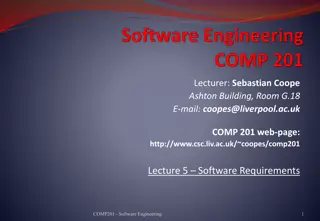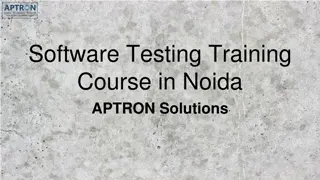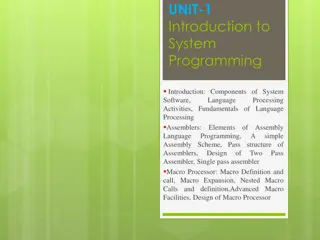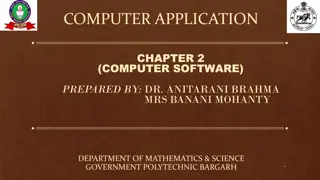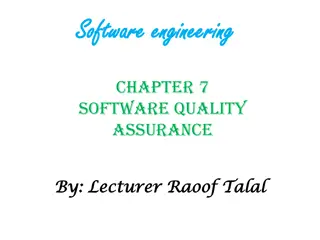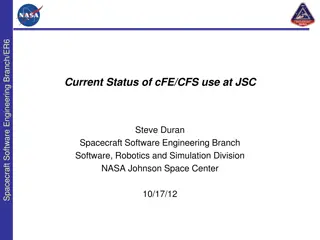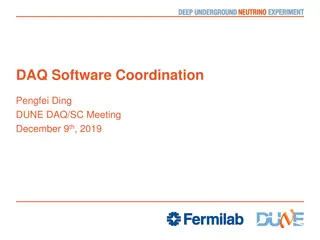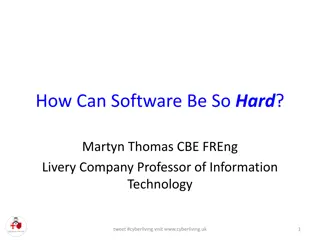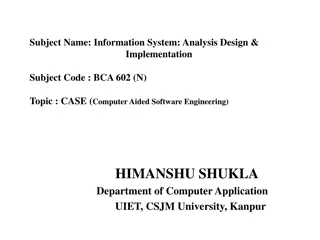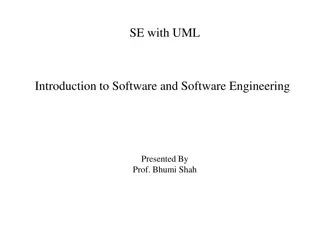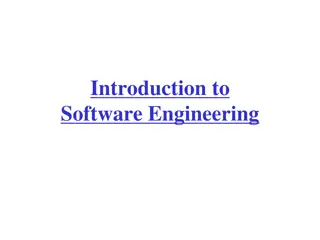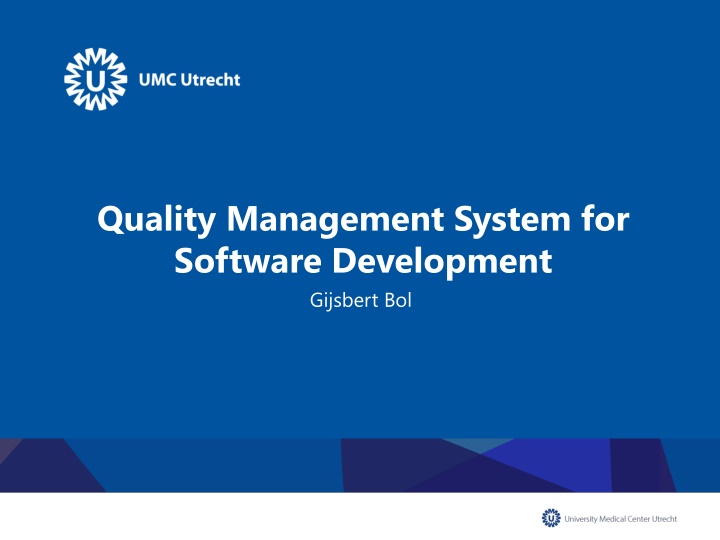
Quality Management System for Software Development
The regulations, norms, and legal framework related to medical device software development. Learn about ISO standards, MDR regulations, and the definition of medical devices. Discover how to navigate the quality management system for software development in the healthcare industry."
Download Presentation

Please find below an Image/Link to download the presentation.
The content on the website is provided AS IS for your information and personal use only. It may not be sold, licensed, or shared on other websites without obtaining consent from the author. If you encounter any issues during the download, it is possible that the publisher has removed the file from their server.
You are allowed to download the files provided on this website for personal or commercial use, subject to the condition that they are used lawfully. All files are the property of their respective owners.
The content on the website is provided AS IS for your information and personal use only. It may not be sold, licensed, or shared on other websites without obtaining consent from the author.
E N D
Presentation Transcript
Quality Management System for Software Development Gijsbert Bol
Introduction (1) UMCU computer science team 4 core members Clinical software Delineation software Dicomserver Workflow software Pre-clinical software MRLTP Tracking/gating software Autosegmentation MR patches Research software
Introduction (2) Archiving, versioning and documentation Source code repositories Git Test reports Responsibility Clinical physics First-in-man MRLinac treatment (2017) Relied heavily on in-house software Technical file required IGZ and internal METC Regulations? Norms? 2020!!!
Regulations and Norms MDD 93-42EEG Medical Devices Directive MDR-2017/745 Medical Device Regulations
Regulations and Norms MDD 93-42EEG Medical Devices Directive MDR-2017/745 Medical Device Regulations ISO 13485 Medical devices Quality management systems - Requirements for regulatory purposes ISO 14971 Medical devices - Application of risk management to medical devices ISO/IEC 62304 Medical device software Software life cycle processes
Legal framework Medical Device Regulation 2017 (MDR) MDR aims: Balances patient care and small / medium-sized enterprice interests High standard regarding quality and safety regarding MDs Data generated by MDs are reliable and robust Protection of subjects participating in clinical investigations Applies to the whole EU Adopted from May 26th, 2020
Medical device definition Any instrument, apparatus, appliance, software, implant, reagent, material or other article intended by the manufacturer to be used, alone or in combination, for human beings for one or more of the following specific medical purposes: Diagnosis, prevention, monitoring, prediction, prognosis, treatment, compensation or alleviation of disease, injury or disability Investigate, replacement or modification of anatomy or a physiological or pathological process
Software can be a medical device MDR definition: Software shall also be deemed to be an active device Active device: Any device, the operation of which depends on a source of energy and which acts by changing the density of or converting that energy Software can be regarded as a medical device with a power cord
Classification (ISO 13485) Governed by the intended purpose of the devices Software, which drives a device or influences the use of a device, shall fall within the same class as the device If the software is independent of any other device, it shall be classified in its own right Classification determines the extend in which a appropriate authority assess the development process and the documentation Notified body (CE) IGZ
Classification (ISO 13485) Provides information to take decisions with diagnosis or therapeutic purposes class IIa Except: Death or an irreversible deterioration of a person's state of health class III Serious deterioration of a person's state of health or a surgical intervention class IIb
Classification (ISO 13485) Monitor physiological processes class IIa Monitor vital physiological processes, variation of the parameter may result in immediate danger to patient class IIb All other: class I MEDDEV 2.4/1 rev. 9 CE certification by a notified body needed: Class IIa, IIb, III
Classification (IEC 62304)
Hospitals (1) Manufacturing, modifying and using devices in-house On a non-industrial scale Specific needs of target patient groups which cannot be met at the appropriate level of performance by an equivalent device available on the market Within the an hospital setting, it is appropriate to provide that certain rules of MDR should not apply, since the aims of this MDR should still be met in a proportionate manner.
Hospitals (2) Software is not transferred to another legal entity Software is developed and used under a appropriate quality management system (QMS) Prove and document that other commerical software is not available for the target patient group s specific needs Provides information to the authorities: Justifying the development, modification and use of the software Understanding the development process, design and indended use of the sofware Asserting the general safety and performance requirements
Hospitals (3) Publicly declare that the software meets the general safety and performance requirements Hospital reviews experience gained Takes all necessary corrective actions
General software development requirements (1) Risk management plan Identify foreseeable hazards Estimate risks during intended use and foreseeable misuse Eliminate or control the estimated risks Evaluate the impact and amend control measures
General software development requirements (2) Design and development Software development life cycle V-model:
General software development requirements (3) Technical documentation Specification, requirements, design, development, safety Verification and validation Verification: Are we building the system right? Validation: Are we building the right system? Pre-clinical and clinical data
Quality Management System (1) Provides: QMS user roles: task / responsibility / competence Procedures Risk managment procedures Quality management procedures Development procedures Forms Stores for each software project: Risk analyis data Verification and validation data Test data Produces for each software project: Technical file Notified body (CE) IGZ
Quality Management System (3) Norms: ISO 13485 and ISO 14971 General QMS for medical devices ISO 62304 QMS for medical software Software development life cycle processes QMS certification: A QMS can be certified under ISO 13485 and ISO 14971 only
UMCU implementation Git Latex PDF publishing Electronic signing
UMCU implementation Git Latex PDF publishing Electronic signing Git server gitolite Build (unit) test system maven Document Management System Review/approve seeddms Issue tracker
Involvement Requirements Risk analysis Implementation Testing
FAQ Is configuring == programming? No! Within intended use of manufacturer Can scripts be medical devices? Yes! Medical device definition in MDR Independent of programming language Within intended use of manufacturer Can Excel sheets be medical devices? Yes! Medical device definition in MDR Can programs / scripts / Excel sheets be shared? Only with a CE mark
Links Praktijkgids Medische Informatietechnologie (2018) https://mtintegraal.nl/specials/1/speciale-uitgave- praktijkgids-medische-informatietechnologie HET ONTWIKKELEN VAN MEDISCHE SOFTWARE IS EEN VAK WAARBIJ JE ONDER ANDERE ERVAREN ONTWIKKELAARS, PROJECTLEIDERS EN ARCHITECTEN NODIG HEBT. HET IS STERK AF TE RADEN ZELF TE ONTWIKKELEN ALSDEZE ERVARING EN KENNIS NIET IN HUIS IS.
Conclusions Adhere to norms ISO 62304, ISO 13485 and ISO 14971 Implement a software QMS Procedures, roles, records Programs, scripts and Excel sheets Setup team for each software project Developers (risk analysis, implementation, testing) Clinical physicists (requirements, risk analysis, testing) End users (requirements, risk analysis, testing, bug reports)



